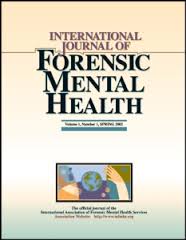A meta-analysis of available literature on gang members’ mental health and emotions reveals that gang members may be at increased risk of suffering from mental illnesses and negative emotions. However, there remains a limited understanding of how gang members’ self-conscious emotions may relate to persistent offending and violence. Gang members may benefit from more clinically tailored interventions that support their mental and emotional health. This is the bottom line of a recently published article in The International Journal of Forensic Mental Health. Below is a summary of the research and findings as well as a translation of this research into practice.

Featured Article | The International Journal of Forensic Mental Health| 2018, Vol. 17, No. 3, 223-246
Gang membership, Mental Illness, and Negative Emotionality: A Systematic Review of the Literature
Author
Sarah Osman, Centre for Research and Education in Forensic Psychology, Keynes College, University of Kent, Kent, Canterbury, UK
Jane Wood, Centre for Research and Education in Forensic Psychology, Keynes College, University of Kent, Kent, Canterbury, UK
Abstract
Gang-related violence poses detrimental consequences worldwide. Gang members suffer a range of adverse experiences, often as victims who then transition to adolescence and early adulthood as offenders. Such experiences may negatively affect their mental health. Yet, the relationship between gang membership and mental illness is, to date, not well understood. This systematic review synthesized the literature on gang members’ mental health and emotions.
A two-part search strategy of electronic and hand searches, dated from: January
1980–January 2017, was conducted. A total of n = 306 peer papers were included in a preliminary scoping review, of which n = 23 met the inclusion criteria and study outcomes. Narrative synthesis revealed how gang members may be at increased risk of suffering from mental illnesses and negative emotions, such as anger and rumination. Yet, synthesis showed that understanding remains limited regarding gang members’ experiences of self-conscious emotions and how such emotions might link to persistent offending patterns and violence. The results suggest gang members may benefit from clinically tailored interventions to support their mental and emotional health. Clinical and research implications are discussed to inform future empirical, intervention, and prevention work with gang members and individuals at risk of gang involvement.
Keywords
Emotions, gangs, mental illness, psychological, violence
Summary of the Research
“To date, gang membership has received scholarly attention, both theoretically and empirically, from an array of disciplines…In this breadth of literature, researchers have frequently examined how proclivity for gang involvement may be heightened by risk factors spanning five core domains: community, family, individual, peer, and school…examining links between gang membership and mental illness could deepen our understanding of gangs and as such, is a nexus, which warrants further investigation…The aim of this review is to synthesize current literature on gang members’ mental health and their emotions. Consideration of how mental illness and emotions link to gang involvement before, during, and/or following gang membership may have significant implications for theory development, empirical directions, and prevention and intervention programs that seek to reduce gang membership” (p. 223-224).
“Findings from [prior researchers] show that gang involvement relates to a range of problems such as antisocial personality disorder (ASPD), anxiety, conduct disorders, posttraumatic stress disorder (PTSD), paranoia, and psychosis…gang members, compared to violent and non-violent men suffer from higher levels of, and seek more professional help for, mental health difficulties such as anxiety, psychosis, and substance abuse” (p.225).
“…Narrative synthesis reveals gaps in the literature and methodological issues that preclude conclusions regarding the casual mechanisms between variables…Nonetheless, our findings suggest that gang members are a vulnerable sub-group of offenders who have a range of mental health and potentially, emotional needs. This review also included female gang members yet they appeared in only a handful of studies. For instance, despite the lack of clarity regarding the causal mechanism between gang membership and mental health, the findings by Kerig et al. (2016) revealed how PTSD symptoms among gang members was associated with the perpetration of violent crimes, but only female gang members had levels of symptoms relevant to the criteria for post-traumatic stress diagnosis. This suggests that gender differences may have significant implications for gang research and interventions, especially given the current reported increase in female gang participation…” (p.233).
Translating Research into Practice
“The measures for diagnosing mental health in studies also employed differential measures which were designed for varying populations (e.g., measures for clinical vs. community samples). This has clinical implications since some gang members may, dependent on the assessment used, be wrongly, or not, diagnosed. Inaccurately identifying the mental health needs of gang members, who may have a range of unmet needs, may contribute further to maladaptive behavior and contribute to the onset and/or persistence of mental illness…Any diagnosis with this population should be approached with caution given that most gang members reside in urban neighborhoods characterized by significant socio-economic deprivation, where delinquency and gang membership may be used as a means of coping…gang members’ elevated fear of victimization, anxiety, and reported increased service use suggests that their needs are several. Thus, future research should learn from existing studies and engage in multi-agency work including systematic practice between the criminal justice system and mental health services to develop appropriate mental health screening tools specific to gang members” (p.233).
“Indeed, the extent to which current interventions in the CJS [criminal justice system], such as gang exit programs include targeting the emotional and mental health needs of gang-affiliated individuals and members is unclear…with trauma-related interventions for gang members only introduced in recent years…It is also imperative that emotions are given more attention in the gang literature. The examination of gang members’ emotional experience has important implications for their treatment, in addition to, prevention work among vulnerable individuals at risk of gang involvement. For instance, we do not know how emotional experiences, such as guilt and shame, vary according to differential involvement and status within a gang. We also do not know if gang affiliates become increasingly prone to experiencing guilt due to their fleeting, as opposed to fixed, involvement with gang-related criminality…Thus, there are significant clinical, research, and policy implications invested in conducting research related to the mental and emotional health of gang members…Nonetheless, methodological issues such as the measurement of mental health and study designs must be addressed if gang research is to influence clinical and policy settings and benefit individuals and communities” (p.234).
Other Interesting Tidbits for Researchers and Clinicians
“Furthermore, affiliate gang members (who have loose association to the gang) have been found to be as at risk of mental illness are core gang members (committed to the gang…)…this seems to suggest that as gang membership deepens, so too do mental health problems. Comparisons between gang and non-gang prisoners also shows that gang members suffer higher levels of anxiety, paranoia, and PTSD – and that each relates strongly to exposure to high levels of violence before incarceration…Although research suggests that gang membership generally attracts discontented adolescent males…it also shows increasing levels of female gang involvement…Given the relationship between gang membership and violent offending, and the association between offending and the increased risk of violent victimization…both males and females can suffer violence due to gang connections. Moreover, due to the consistent evidence regarding the relationship between how childhood and/or adolescent exposure to violence, particularly when coupled with community violence exposure, is related to mental illness…investigating the relationship between gang involvement and mental illness in male and female gang members seems crucial for effective tackling of gang membership” (p.225).
Join the Discussion
As always, please join the discussion below if you have thoughts or comments to add!







